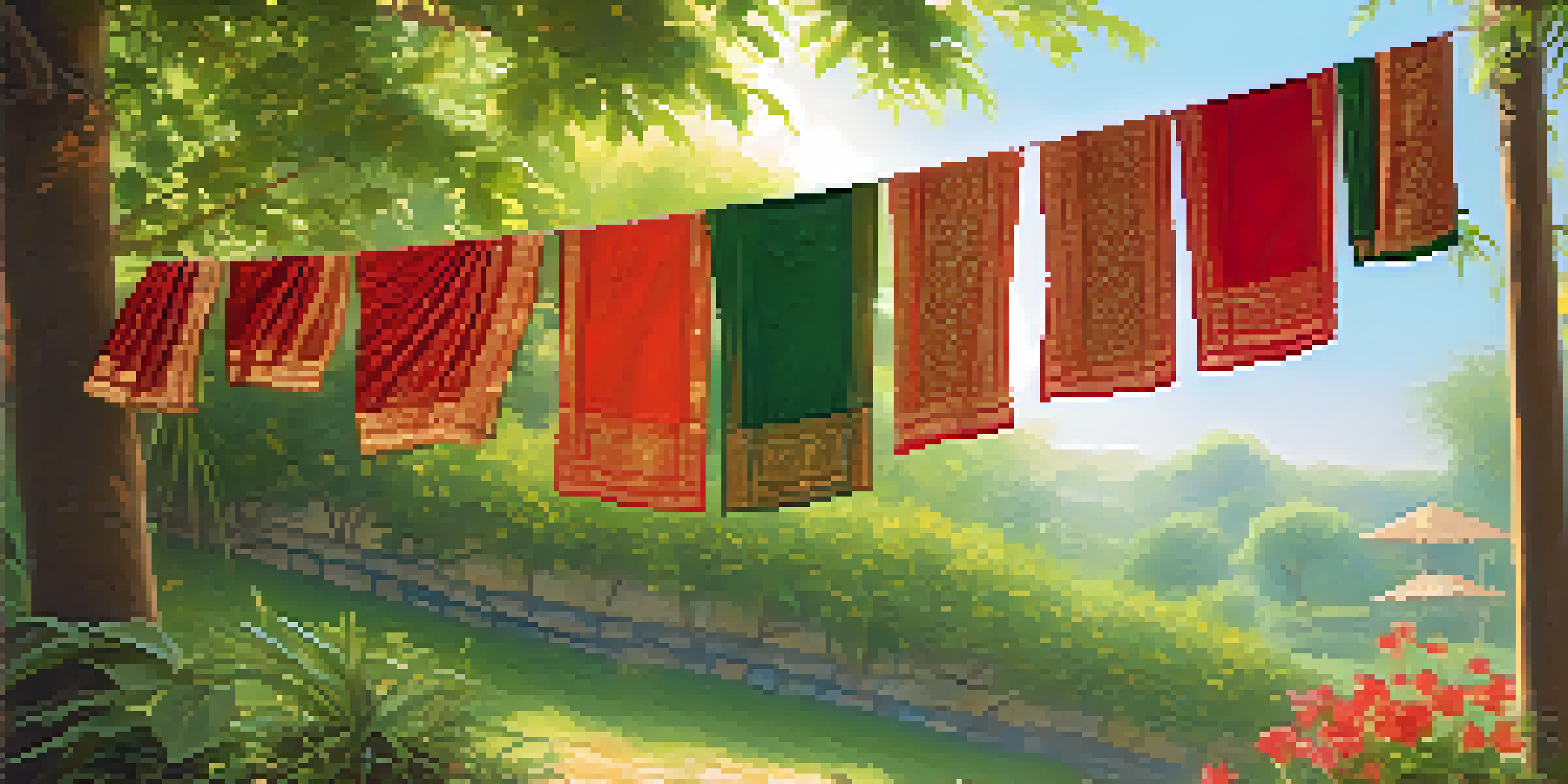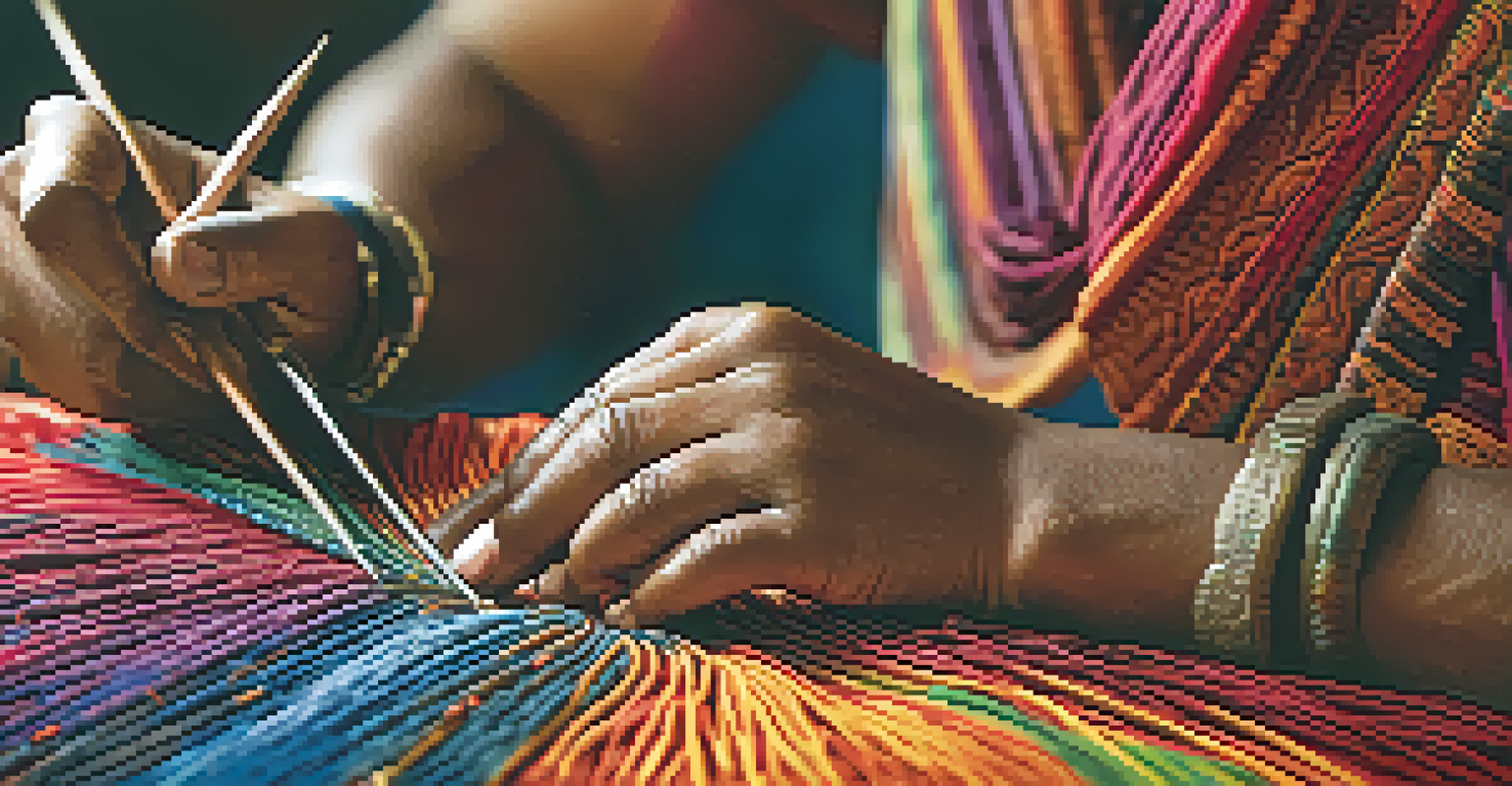The Interplay of Tradition and Globalization in Fashion Design

Understanding Tradition in Fashion Design
Tradition in fashion refers to the longstanding practices, styles, and techniques that have been passed down through generations. These elements often reflect a culture's history, values, and identity, showcasing unique textiles, patterns, and silhouettes that tell a story. For example, the intricate designs of Indian saris or the classic elegance of Scottish tartans illustrate how deeply rooted traditions influence contemporary styles. By honoring these traditional elements, designers can create pieces that resonate with cultural significance.
Fashion is the armor to survive the reality of everyday life.
However, as the world becomes more interconnected, the challenge arises in balancing these traditions with modern innovation. The essence of tradition often lies in its authenticity, which can be threatened by the rapid pace of globalization. Designers must navigate this delicate balance, ensuring that while they draw inspiration from their roots, they also embrace new ideas and techniques that can enhance their work.
Ultimately, tradition in fashion isn't just about preserving the past; it's about evolving it. By weaving traditional elements into modern designs, fashion can create a dialogue between the old and the new, fostering an appreciation for cultural heritage while also pushing boundaries. This interplay enriches the fashion landscape and invites consumers to engage with fashion on a deeper level.
Globalization's Impact on Fashion Trends
Globalization has dramatically transformed the fashion industry, making it more accessible and interconnected than ever before. Trends that emerge in one part of the world can quickly spread to others, thanks to social media and online platforms. For instance, the popularity of streetwear, which originated in urban centers, can now be seen in fashion weeks all over the globe, influencing designs and consumer choices alike. This rapid exchange of ideas has led to an unprecedented blending of styles and cultures.

While this connectivity fosters collaboration and diversity, it also raises questions about cultural appropriation. Designers must tread carefully when incorporating elements from other cultures, ensuring that they do so with respect and understanding. For example, using indigenous patterns without acknowledging their significance can lead to backlash and claims of exploitation. It’s crucial for designers to engage with cultural narratives authentically and ethically.
Tradition Meets Modern Innovation
Designers are blending traditional elements with contemporary styles to create culturally significant fashion that evolves over time.
Moreover, globalization has opened the doors for emerging designers from diverse backgrounds, allowing them to showcase their unique perspectives on international platforms. This democratization of fashion is vital for enriching the industry and ensuring that a wide range of voices and stories are heard. As the fashion world continues to evolve, it becomes essential to appreciate this global tapestry while honoring its roots.
The Role of Technology in Bridging Traditions and Trends
Technology plays a pivotal role in the intersection of tradition and globalization in fashion design. Innovations such as 3D printing, digital printing, and virtual reality have transformed how designers create and present their work. For example, digital printing allows for the intricate patterns found in traditional textiles to be reproduced with greater accuracy and at a lower cost, making them more accessible to a broader audience. This means that traditional designs can reach new markets without losing their essence.
Style is a way to say who you are without having to speak.
Additionally, social media has become a powerful tool for showcasing traditional craftsmanship to a global audience. Platforms like Instagram allow artisans from remote villages to share their work, attracting attention from fashion enthusiasts and brands alike. This exposure can lead to collaborations that help preserve traditional techniques while also infusing them with contemporary flair, demonstrating how technology can serve as a bridge between the past and the present.
However, the reliance on technology also presents challenges, such as the potential loss of artisanal skills and craftsmanship. As more brands turn to mass production and digital solutions, there’s a risk of sidelining traditional methods that require time, patience, and expertise. It becomes essential for the industry to strike a balance, integrating technology in ways that enhance rather than diminish the value of traditional fashion practices.
The Fashion Industry's Cultural Responsibility
As fashion designers and brands navigate the interplay of tradition and globalization, they must also consider their cultural responsibility. This involves recognizing the impact their designs have on communities and the potential consequences of their creative choices. For example, when a high-profile brand uses traditional motifs from a particular culture, it’s vital for them to acknowledge the source and give credit where it’s due. This practice not only respects the heritage but also fosters goodwill between cultures.
Moreover, ethical fashion is gaining prominence as consumers become more conscious of the stories behind their clothing. Brands that prioritize sustainability and fair labor practices resonate more with today’s audience, prompting a shift in how fashion is perceived. By embracing ethical practices, designers can honor traditions while contributing positively to global communities, creating a win-win scenario.
Globalization and Cultural Sensitivity
As fashion becomes more interconnected, designers must navigate the complexities of cultural appropriation while respecting heritage.
Ultimately, the fashion industry's cultural responsibility extends beyond profit; it’s about fostering an environment where diverse voices can thrive. By promoting inclusivity and respect for cultural heritage, designers can create a more equitable fashion landscape that celebrates the beauty of diversity while ensuring that traditional practices are not lost in the tide of globalization.
Case Studies: Successful Blends of Tradition and Modernity
Throughout the fashion world, there are numerous examples of designers who have successfully blended traditional elements with modern aesthetics. Take the example of Japanese designer Issey Miyake, who often incorporates traditional Japanese garment-making techniques into his innovative designs. His ability to merge the old with the new not only honors his heritage but also captivates global audiences, illustrating how tradition can be reimagined in contemporary contexts.
Another fascinating case is the rise of African fashion designers who are making waves on international runways. Brands like Ozwald Boateng and Adebayo Oke-Lawal have brought traditional African textiles and patterns into the limelight, showcasing their cultural richness while appealing to a global market. Their work demonstrates how embracing cultural heritage can lead to fresh interpretations that resonate with diverse audiences.
These case studies highlight the potential for creativity that lies in the fusion of tradition and globalization. By drawing from their roots while exploring new avenues, designers not only enhance their own work but also contribute to a richer, more diverse fashion narrative. This blending of influences encourages a broader understanding of fashion as a dynamic art form that evolves continuously.
Consumer Influence on Tradition and Globalization in Fashion
Consumers today hold significant power in shaping the fashion landscape, especially regarding how tradition and globalization interact. With the rise of social media influencers and online communities, individuals are more vocal about their preferences, demanding transparency and authenticity from brands. This shift has led many designers to reassess their creative processes, ensuring that they incorporate elements that resonate with their audience while remaining true to their roots.
Moreover, the growing trend of personalization in fashion allows consumers to seek out pieces that reflect their unique identities. As people become more interested in storytelling through clothing, they gravitate toward designs that honor traditional craftsmanship or represent a cultural narrative. This demand encourages designers to explore their heritage and draw inspiration from their backgrounds, leading to a more diverse marketplace.
Consumer Power Shapes Fashion Trends
Today's consumers influence fashion by demanding authenticity and personalization, encouraging designers to honor traditions in their creations.
As a result, the interplay between consumer behavior and fashion design is dynamic and evolving. Designers who listen to their audience and adapt to their needs can create pieces that not only celebrate tradition but also embrace the global influences that shape contemporary fashion. This mutual relationship fosters a sense of community and belonging, making fashion a more inclusive and engaging experience for all.
The Future of Fashion: A Harmonious Blend of Influences
As we look toward the future of fashion, the interplay between tradition and globalization will continue to evolve, presenting both opportunities and challenges. With increasing awareness of cultural significance and ethical practices, designers are now more equipped than ever to create collections that honor their heritage while appealing to a global audience. This harmonious blend can lead to innovative designs that resonate on multiple levels, enriching the fashion experience for everyone involved.
Additionally, as technology advances, the potential for collaboration among diverse cultures will only grow. Virtual reality, for instance, may allow consumers to experience the craftsmanship behind traditional garments from around the world, fostering a deeper appreciation for cultural diversity. This immersive experience can help bridge the gap between consumers and creators, making fashion a more interactive and meaningful endeavor.

Ultimately, the future of fashion lies in the hands of those who are willing to embrace change while honoring the past. By fostering a dialogue between tradition and globalization, designers can pave the way for a more inclusive and vibrant fashion industry that celebrates the beauty of diversity and the richness of cultural heritage. The journey is ongoing, but the possibilities are endless.